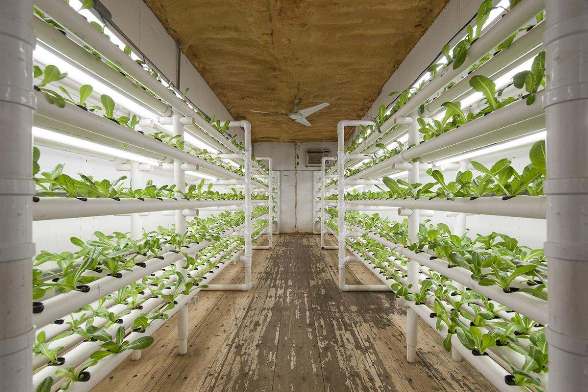
As a natural result of importing more than we export the United States takes in far more shipping containers than we fill. The imbalance leaves our seaports with stock piles of empty containers crying to be recycled. Human innovation has responded with shipping container sculptures, homes, malls, motels, playhouses, and more recently as a portable year round garden. The idea of growing in a shipping container is ingenious on many levels.
The containers themselves are inexpensive and nearly indestructible with over 320 square feet of growing space in each 40 foot container. The infrastructure for transport already exists so they can be easily moved by ship, truck, or train. Once outfitted with the proper environmental controls, the shipping container could provide an instant garden anywhere in the world with access to electricity.
A company called PodPonics in Atlanta has provided a model for local food production growing greens for local businesses. The CEO, Matt Liotta, is producing the equivalent of an acre worth of lettuce in each 40 foot container. The containers can be placed close to the point of consumption on land that is otherwise non-arable and produce greens 365 days a year regardless of the weather. The system is able to produce these greens using a fraction of the water required for traditional farming and without the use of pesticides.
He integrated LED plant lighting into the system and was able to reduce his energy cots. With crops like microgreens the need for traditional lighting was eliminated entirely resulting in less energy use and virtually no heat production within the container. For crops such as tomatoes, running a hybrid LED and HID system reduces energy consumption and cooling requirements.
The future could bring a day where instead of delivering food aid, we deliver shipping container gardens equipped with solar panels to famine stricken areas. Fresh perishables are already shipped in a controlled transport environment, with the addition of LEDs and solar panels we may someday see plants that are actually growing in transit to be harvested on site. Without the heat of traditional lighting, the possibility of multi-tier planting beds is feasible replacing one level with three. While an end to our trade deficit doesn’t appear to be around the corner, the shipping container garden may soon be.
Angela Lundmark is an indoor gardener and freelance writer.
Related Articles & Free Email Newsletter
Maintenance on Indoor Gardening and Greenhouse Equipment



Comment here